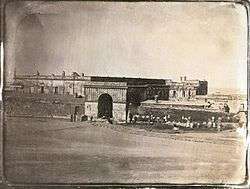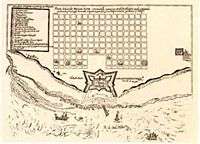Fuerte de Buenos Aires
Fuerte de Buenos Aires was the main Spanish fortress of the city of Buenos Aires during the colonial period.[1]
| Fuerte de Buenos Aires | |
|---|---|
 Daguerreotype of the Fort of Buenos Aires | |
| Type | Military fortress |
| Area | Monserrat, Buenos Aires |
| Site information | |
| Owner | |
| Condition | demolished |
| Site history | |
| Built | 16th century |
| Battles/wars | British invasions of the Río de la Plata |
History
The Fort of Buenos Aires was built by order of the governor Fernando de Zárate, being designated with the name of Real Fortaleza de Don Juan Baltasar de Austria.[2] Its construction began towards the middle of 1590s, in the land where the Government House is currently located. Originally the fortress had been raised for the defense of the city against possible incursions by pirates, was also the residence of the authorities of Buenos Aires.[3]
Among the General Staff of the Fort of Buenos Aires were the Captains Francisco Pérez de Burgos, Miguel de Riglos, Miguel Gerónimo de Esparza and his son Juan Miguel de Esparza, who had also served as Mayors of the City in various periods.[4]
During the early 17th century, no major modifications were made to the structure of the Fort of Buenos Aires, being completely modified towards the year 1708, when the colonial authorities hired the Captain engineer José Bermúdez, who endowed the fort with a fortified wall.[5] In 1725, the fort was modified again, this time by the engineer Domingo Petrarca.[6]
Towards the middle of the 18th century, the Fort of Buenos Aires continued with the renovations, carried out by the Spanish engineer of British descent, Don Juan Bartolomé Howell.[7] And later by the engineer Carlos Cabrer, who built a Chapel for the Viceroys.[8]
During the British invasions of the River Plate, the Fort of Buenos Aires, was occupied by William Beresford, who resided in the fortification until surrendering to Santiago de Liniers.[9] In 1810 the Fort of Buenos Aires, was used as the official residence of Cornelio Saavedra, president of the Primera Junta of Government.[10]
In 1826, the President Bernardino Rivadavia, made important improvements in the Buenos Aires fort, including an iron gate to replace the rudimentary wooden gate.[11]
Gallery
 painter of the El Fuerte de Buenos Aires by Emeric Essex Vidal
painter of the El Fuerte de Buenos Aires by Emeric Essex Vidal drawing of the Fuerte de Buenos Aires
drawing of the Fuerte de Buenos Aires cannons of the Fuerte de Buenos Aires
cannons of the Fuerte de Buenos Aires key to open the gate of the Fuerte de Buenos Aires
key to open the gate of the Fuerte de Buenos Aires lock of the Fuerte de Buenos Aires
lock of the Fuerte de Buenos Aires shield of the Fuerte de Buenos Aires
shield of the Fuerte de Buenos Aires Doorknob that belonged to the Fuerte de Buenos Aires
Doorknob that belonged to the Fuerte de Buenos Aires plane of the Fuerte de Buenos Aires by José Bermúdez
plane of the Fuerte de Buenos Aires by José Bermúdez view from the northwest of the Fuerte de Buenos Aires
view from the northwest of the Fuerte de Buenos Aires
References
- Orígenes del fuerte de Buenos Aires, Enrique de Gandía
- Tradiciones y recuerdos de Buenos Aires, Manuel Bilbao
- Cronología artística:, Universidad de Buenos Aires. Instituto de Historia del Arte
- Cuestion de limites inter-provinciales entre Buenos Aires, Cordoba y Santa-Fé, Aristóbulo del Valle
- El fuerte, Buenos Aires (Argentina)
- Catálogo del Museo Histórico Nacional, Volume 1, Museo Histórico Nacional (Argentina)
- Enciclopedia del arte en América, Volume 1, Bibliográfica OMEBA, 1969
- Arquitectura hispanoamericana en el Río de la Plata:, CEDODAL, Jan 1, 2006
- Las invasiones inglesas al rió de la Plata (1806-1807), Juan Beverina
- El presidente Saavedra y el pueblo soberano de 1810, A. Estrada, 1960
- Buenos Aires desde setenta años atrás, 1810-1880, José Antonio Wilde